By Phil Bergman
This article deals with basic greenhouse culture of palms, problems that can be encountered, special requirements of greenhouse growing, and other topics of interest on the subject.
INTRODUCTION
Greenhouse culture is a means of providing a plant an improved growing environment within an artificial structure to improve its growth and survival. It is paramount to describing what a grower in a colder or dryer environment does to mimic the conditions that a grower in a warmer, more moist environment has naturally in his backyard. There are heated greenhouses that maintain a minimum temperature. There are cold frames that only use the passive solar heat with no supplemental heat. And, there are greenhouse that even cool the air. Most greenhouses maintain a higher indoor humidity. All greenhouse are an attempt to give the plant preferable growth conditions and control and stabilize the environment.
So, in describing greenhouse culture, one must discuss what is ones goal with the greenhouse and in what locality does one live. Greenhouses are used for seed germination, vegetative propagation, maximizing growth, creating tropical environments, commercial production of plants, and just for fun. For propagation, one wants to maintain good humidity, adequate warmth, and less than full sun. For pushing growth on Bismarckia, one would want a dry greenhouse with good light, very high temperatures and very little humidity. For high elevation Geonomas, one would want a cooler greenhouse with a narrow temperature spread and high humidity. Thus, one can understand that no simple formula or set of rules will apply to all greenhouse culture. Despite these limitations, I will discuss important topics regarding greenhouse container culture of palms, especially as reflected by my experience in Southern California. Remember to use the greenhouse when it is needed. If a species grows just as fast and just as well outdoors, why use the greenhouse?
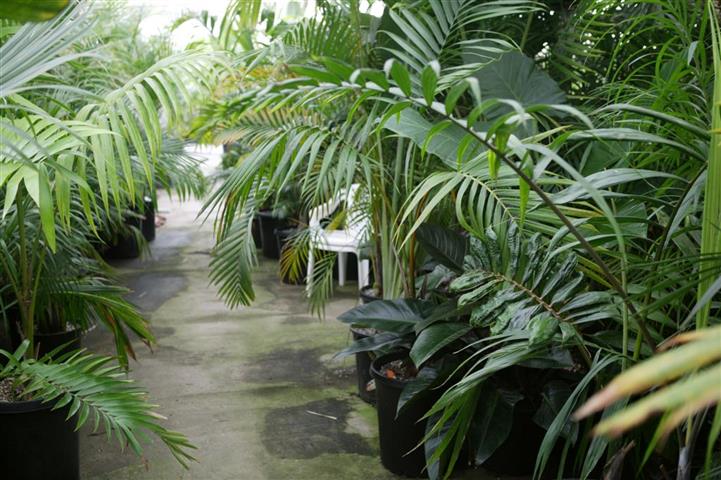
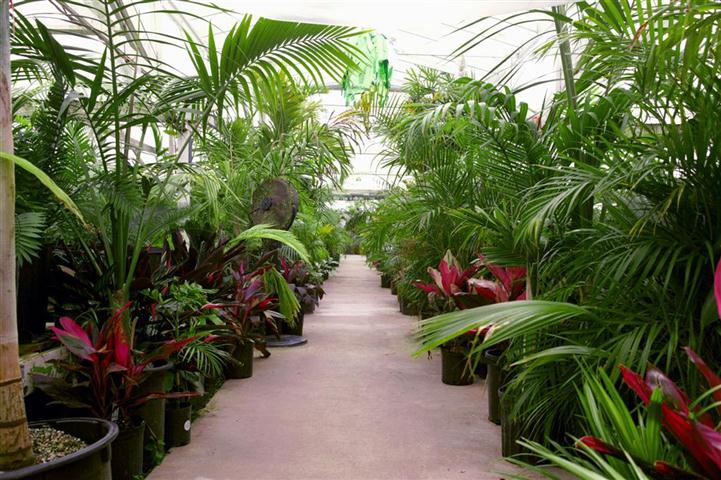
WHY HAVE A GREENHOUSE?
There is a debate over what is the best size to introduce a palm to your outdoor environment. Does a species do better if exposed to cold as a two leaf seedling or should one wait for a larger juvenile plant? Although this may vary from species to species, most growers have come to realize that a species success with cold may be improved if one starts with a larger plant, preferably at least one half meter in size, typically in a 10 to 20 liter container. This may necessitate someone using a greenhouse to get the plant up to this critical mass. This would not apply to those readers living in a tropical or warm subtropical zone. For those living in more temperate regions, however, this is a critical problem and the greenhouse may make the difference between success and failure on getting the plant to obtain enough size to be grown outdoors. For decades I saw certain species remain as a two leaf seedling year after year with outdoor culture. The same seedling in the greenhouse in the same time would have been well on its way to a good size for outdoor planting.
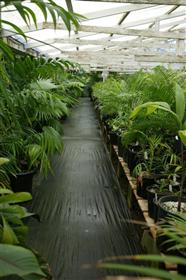
TEMPERATURES
A well constructed and operated greenhouse controls and stabilizes the growing environment. This is accomplished utilizing thermostats, humidistats, fans, coolers, and other greenhouse apparatus. A must is mounting several hi-low thermometers to know what the greenhouse is really doing. The most important goal is to maintain a minimum temperature during cold weather. A minimum temperature of 18.5 degrees C would be acceptable for almost all palms, but this may be financially prohibitive. I’ve found that a minimum of 10 degrees C allows me to grow about 98% of the palm species I’ve come across. Regarding maximum temperatures, there are very few species that want temperatures in excess of 32 to 33 degrees C. Certain genera, such as Breahea, Bismarckia, Nannorrhops, and Washingtonia like temperatures even higher, but these are the exception. Your Chamaedorea, Howea, Lepidorrhachis, Hedyscepe, Geonoma, Rhopalostylis, Asterogyne, and many mountain species will succumb when faced with such extreme high temperatures. To avoid exceeding such maximum temperatures, one can use cooling apparatus, intake and exhaust fans, interior air circulation with water mist, and overhead sun protection in the form of shade cloth or white wash paints. Most growers implement several of the previous techniques.
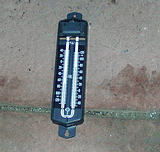
LIGHT
Sunlight can be quite intense in the greenhouse. Without protection, the leaves of some of your palms will become bleached out and yellow. One can utilize shade cloth or water based white wash pain on plastic greenhouses. Different densities of shade cloth and different concentrations of the paint can fine tune the light in any particular area of the greenhouse. Observation of plant appearance is more valuable than a light meter. Too much light will produce faded, yellow and sometimes burnt leaves on the palms. Too little light produces green but stretched out and unstable plants that lack vigor.
Adjusting your shade in either direction will solve each of these two problems and consistency can be obtained by utilizing a light meter. Also, coordinate the amount of sun that enters a greenhouse with the type of plants that you are growing. Some types light a lot of intense sun (cycads, succulents) while others don’t (shade palms, tropical foliage).
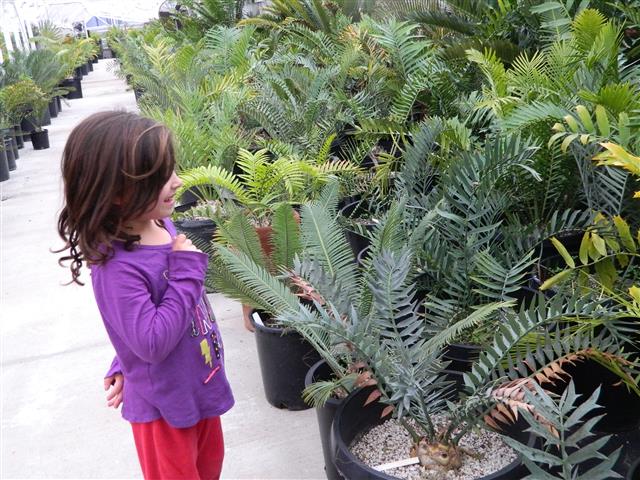
HUMIDITY
Humidity should be maintained at about 50 to 60% for most species. This can be accomplished by spraying the greenhouse walkways with water on a regular basis or by utilizing electronically controlled misting devices. The optimal humidity levels obviously depends on what is being grown, but I have found this level to be adequate for most species. Too little humidity leads to leaf desiccation, frequent watering requirements, red spider and other pest infestations, and overall poor performance. Too much humidity makes the greenhouse slippery with algae and slimy and sooty molds. One will get algae buildup on the soil and leaves. This can lead to fungal problems and rot. A purchased humidistat can monitor and control humidity levels. Adequate air circulation can help overcome some of the algae/mold problems and is crucial in other ways.
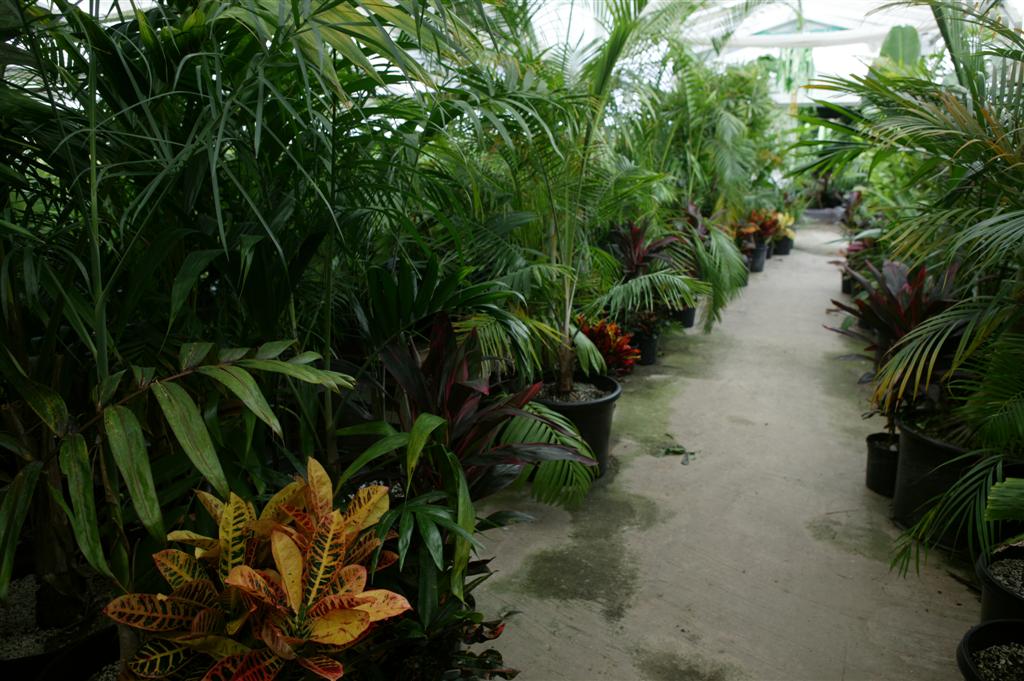
AIR CIRCULATION
Adequate air circulation is the most forgotten factor in the greenhouse environment. Greenhouses have two types of fans. First, thermostatically controlled exhaust fans which mainly serve to cool the greenhouse by blowing out hot air and passively pulling in cooler outside air. They likewise provide some interior air circulation. Second, circulating fans that are set on timers, independent of temperature, and circulate air within the greenhouse. Interior circulation fans last several years as they go for hours a day. Count on replacing them every several years. Two are shown to the right.
For larger greenhouses, exhaust fans are quite powerful blades over a meter in size. One can utilize intake fans for cooling but this is limited by the physical agitation such fans would cause on the plant material inside the house. On small greenhouses, temperature sensitive hydraulic devices can open vent windows at the top of the house. One could alternatively just open the doors in the morning and close them at night. Interior circulating fans, however, are important regardless of the size of your greenhouse. They gently circulate air among the plants and are critical for good healthy growth and preventing various greenhouse maladies. Typically they are set to operate 30 minutes on and 60 minutes off in any given locality of the greenhouse.

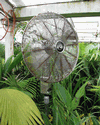
BENCHES
Getting the palms off the ground aids in their growth. This is limited by the size of your plants. Benches avoid the colder ground temperature and help plants get more air circulation. It also makes plant inspection easier and lessens weed problems. Remember to space your plants with air space between them. If you can afford it, plastic benches or ones that won’t rot will save you money in the long run. The benches we have are mostly made from wood and rot out in about seven years. To the right I’m also showing a nicely manufactured plastic bench; last photo.

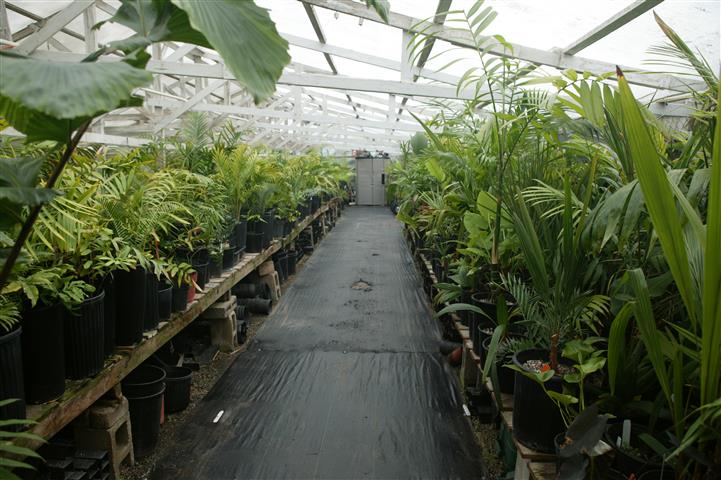
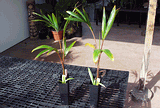
POTTING SOIL FOR PLANTS IN THE GREENHOUSE
Comments on potting soil are similar to those discussed under Container Plants and I’ve written an article about the potting soil we use here at the nursery. In general, in the greenhouse one has to make sure soil drainage is good because of the higher humidity within the greenhouse. Drainage is created by adding air space into the potting soil. Topsoil and very fine sand slow drainage by filling air spaces. Drainage is increased by adding perlite, pumice, peat moss or chunky bark material.
In time, however, the bark and peat moss that you added to increase drainage will decay and slow the drainage. Such aged soil is typically wet and sticky and may have a thin layer of green algae or mold on the surface. Such soils can lead to root rot. A well formulated soil should last two years in the greenhouse. When soils breakdown, repotting into fresh soil is needed. The most basic of well draining greenhouse potting mix would be 50% each of peat moss and perlite. Wetting agents, gypsum, and dolomite can be added to this. Peat moss (and ground sphagnum moss) do have intrinsic antifungal characteristics. However, such a light mix needs a very precise watering program.
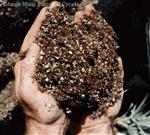
WATERING
All the rules regarding watering described in the Container Culture still apply in the greenhouse. However, because of higher ambient temperatures, pots may dry out more quickly in the greenhouse, especially during a hot dry summer. During the winter, especially if the greenhouse is closed up, pots stay wet much longer. Watering will also be affected by inside humidity levels, air circulation and the soil formulation. One still checks for dryness of the exposed potting soil to determine need for watering and sets a water schedule accordingly.
It is best to water early in the morning or late in the day. Occasional leaching of the soil will help prevent salt buildup. One cannot recommend an optimal watering schedule as the variables above may be totally different in any given greenhouse. Occasionally spraying the foliage might refresh the plant and prevent insect problems. However, continual overhead watering as from fixed misters can lead to algae and bud rot problems. It is best to apply the water directly on the soil. Seedlings and small plants require more careful observation for drying. Newly repotted plants need repetitive initial watering to totally saturate the soil. A triple application of water until it is seen running out the drainage holes usually suffices. For the first several weeks, check newly replanted palms every few days to guarantee adequate soil moisture.
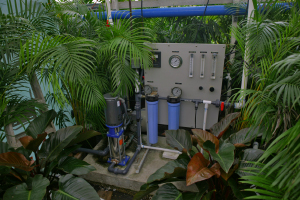
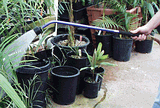
FERTILIZER, INJECTOR SYSTEMS
The greenhouse is the perfect place to utilize an injector system. It can be very cost and time effective. There are many commercial models available on the market. They are sized according to flow rates needed and do not need electricity to function. They utilize soluble fertilizer of any N/P/K ratio needed. A typical fertilizer might be an 18:6:18 or 18:6:12 ratio with microelements and blue indicator dyes. Follow your injectors directions. Even better, also measure the actual fertilizer concentration (parts per million of salt) coming out at the hose end. Electronic equipment on the market does this with ease. Soluble fertilizers usually have a blue dye in them so, as you are watering, you can judge the concentration by the color of the water you see coming out of the hose.
Also, check salt content in the soil once your fertilization program is in place. This is done with affordable equipment as well. Always observe plants for any evidence of salt burn. There is potential for unsightly salt buildup on the foliage if the solution is sprayed on the foliage.
One can also install a reverse osmosis system to improve water quality by removing municipal water salts. Then, an injector system puts back in the desired fertilizer formulae.
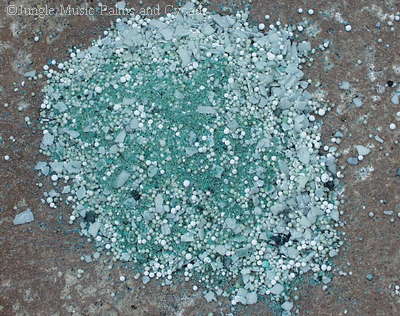
FERTILIZER, OTHER METHODS
If one cannot afford an actual injector system, there are inexpensive alternatives that utilize the venturi principal to siphon in fertilizer concentrate from a small basin directly into the hose. These devices are less accurate and drastically diminish flow rates when compared to actual injectors. They are, however, good for heavier liquid fertilizers such as fish emulsion.
Organic and chemical fertilizers can also be used in the greenhouse. Bloodmeal is good for greening up leaves and carries little risk of burn. It is, however, odiferous. I have found that quick release fertilizers in the greenhouse have to be used very cautiously. Slow release fertilizers diminish risk of burn but are expensive and can still give erratic results. They are dependent on temperature or humidity for their release and this can vary in the greenhouse.
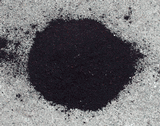
PESTS
Palms are surprisingly pest free. However, any insect which can attack a palm can do so inside the greenhouse, except more voraciously. Infestations typically spread more rapidly in a greenhouse. The most common insect pathogens include aphids, scale, mealy bug and spider mites. When you get an insect problem, often sooty mold follows. The mold works symbiotically with the insects.
When introducing new material into the greenhouse, make sure it is insect free to avoid new infestations. Preventative practices which can reduce problems include: spraying down the foliage, adequately spacing the plants, ensuring good air circulation and humidity, avoid overheating the greenhouse, removing dead leaves and debris, and treating problems as soon as they occur.
For any given pest problem, it is best to consult your local nursery or garden center for the appropriate agent available in your locality. These vary from region to region and country to country. Always follow manufacturers instructions and use appropriate protective gear. Fungal problems are usually related to simultaneous cultural problems. Fungicidal agents must be given the same respect regarding human toxicity as insecticidal agents. Prophylactic use of fungicides as a soil drench on new seedlings is advocated by some growers.
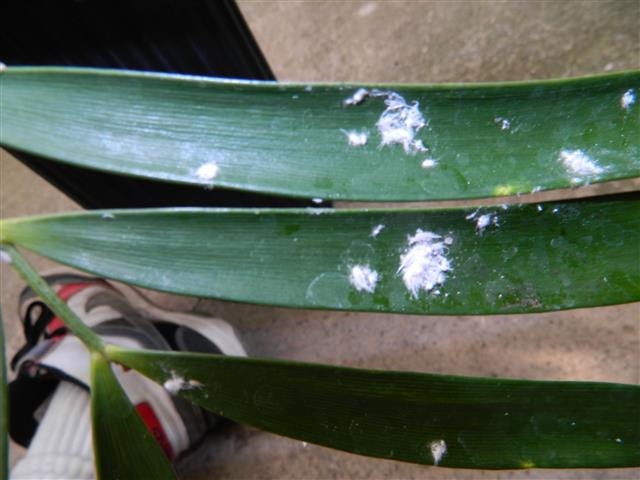
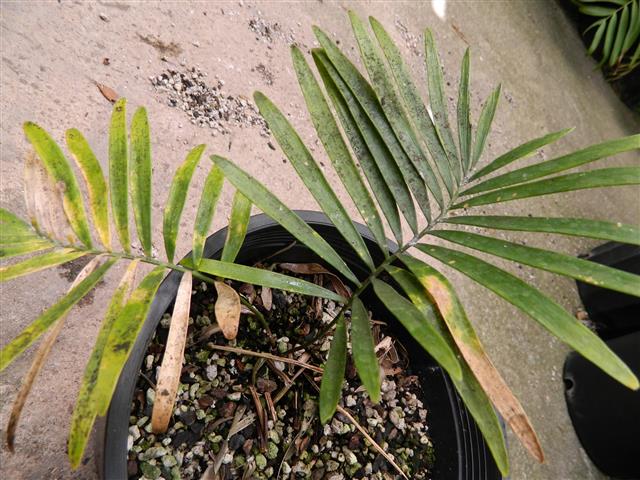
PRUNING
As palms grow faster in the greenhouse, more attention must be placed on pruning dead leaves. Always use clean equipment. Leaves are removed when they are unsightly and detract from the palms beauty. Do not remove healthy green leaves as these leaves are providing photosynthesis and nutrition for the plant. Allow old leaf bases to age such that they can be removed easily without scaring the trunk. Such scars can lead to infections with pink rot (Gliocladium Blight). Leaves should be cut on the lower petiole area as close to the trunk as possible. Cleaning of pruning equipment between plants will reduce transmission of various plant diseases. Do not allow leaf littler and trash to accumulate on the benches and pathways as this leads to fungal reservoirs.
WEED CONTROL
It is imperative to control weeds on the ground and in the containers or they will overwhelm your greenhouse. One can purchase herbicides for some species of weeds. However, most growers hand weed and just keep up with it before the weeds have a chance to flower and seed. Plastic ground covers can be used on the pathways and under benches. Once established these covers remarkably diminish the amount of weeding needed and the need for herbicides.
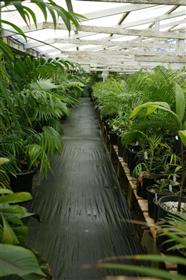
REPOTTING PALM TREES
Repotting of greenhouse container plants follows the same general guidelines as outdoor repotting with a few exceptions. Because of rapid greenhouse growth, it is quite easy for a plant to overgrow its container in a year or two. It does great in the greenhouse, but such a plant may then have too much leaf mass for the available roots and succumb on planting outdoors. Thus, repotting of greenhouse palms is a continual and important activity. To conserve money and utilizing rapid greenhouse growth, many commercial growers will pot a given plant into a container that may initially appear oversized for the plant, knowing that in a relatively short period this plant will grow into the larger container. If this is done, adjust watering patterns on these plants as less water is being consumed by the plant. If minimum greenhouse winter temperatures are maintained at 5 to 10 degrees centigrade or warmer, winter repotting can be done without fear. With lower temperatures, caution may be in order.
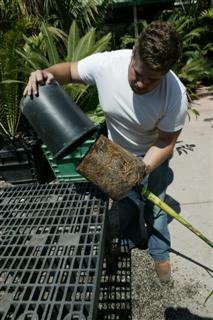
ACCLIMATION OF PLANTS AND TRANSITIONING THEM OUTDOORS
Whether you are a grower or a customer purchasing plants from a greenhouse, acclimation outdoors is of critical importance. There are three things to consider when moving a plant out of the greenhouse: sunlight, temperature, and humidity. Of greatest risk is the outdoor sunlight. Your palm has typically seen less than full sunlight in the greenhouse. Higher humidity levels have also protected its foliage. The most common mistake is to take a sun loving species from the greenhouse and plant it directly into full sun. This invariably gives some degree of leaf burn. The plant actually looks scorched. See photo to right. This is most apparent on the leaves that are directly exposed to the sunlight, giving a faint or prominent brown discoloration to the green leaf.
This can be avoided by gradually moving the plant into sun over a two to three month period. On first removing the palm, put it in shade. Every two to three weeks, progressively move it into a little more sun. If you see signs of burn, back down the gradient and acclimate more cautiously. Greenhouse plants can suffer sunburn any time during the year. Some species are more tolerant of this move, but caution is definitely in order. If a greenhouse plant is destined for filtered light, the acclimation process can be shorter.
Cold burn can be avoided by not moving a plant out during cold weather. Unaccustomed cold can be just as devastating as sun. Make sure any threat of frost has passed. Cold frame greenhouse pose less risk than heated greenhouses. You can tell cold burn from sun burn in that the former is a more universal brown or faded look and will invariably hit the new leaf spear or newest tender foliage. The foliage will also look somewhat wilted and weak with time. Sun burn is on sun exposed areas only.
Most growers have experienced cold damage while experimenting with new species of palms outdoors. Antidessicant sprays may aid with cold damage. Acclimation to less outdoor humidity may also lead to problems. Frequent spraying of the foliage with water and watching the soil for drying are in order. It is possible that a high humidity loving palm species may not survive in your area. However, reproducing a more moist microclimate in your garden may make the difference. Antidessicant sprays may likewise help with humidity problems.
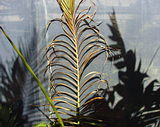
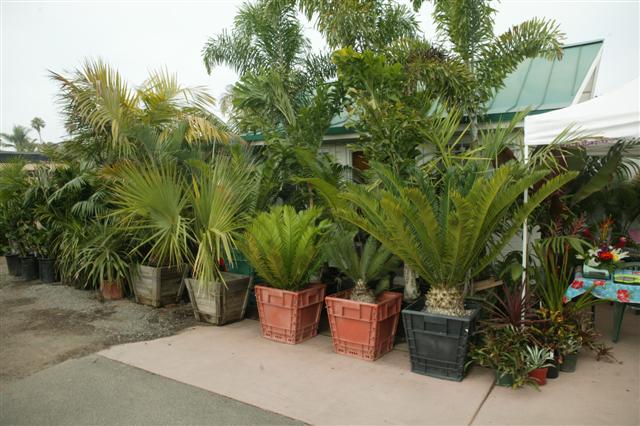
CONCLUSION
In this article I’ve tried to educate the reader about utilizing a greenhouse to grow palm trees or whatever plant species they wish. There’s a lot of things to consider and many potential pitfalls. But, if you approach it logically and scientifically, a greenhouse allows plants to grow faster and maintain a high level of beauty. Top to bottom, consider all the topics discussed above as any one of them can create problems for you over time. Good luck with it.
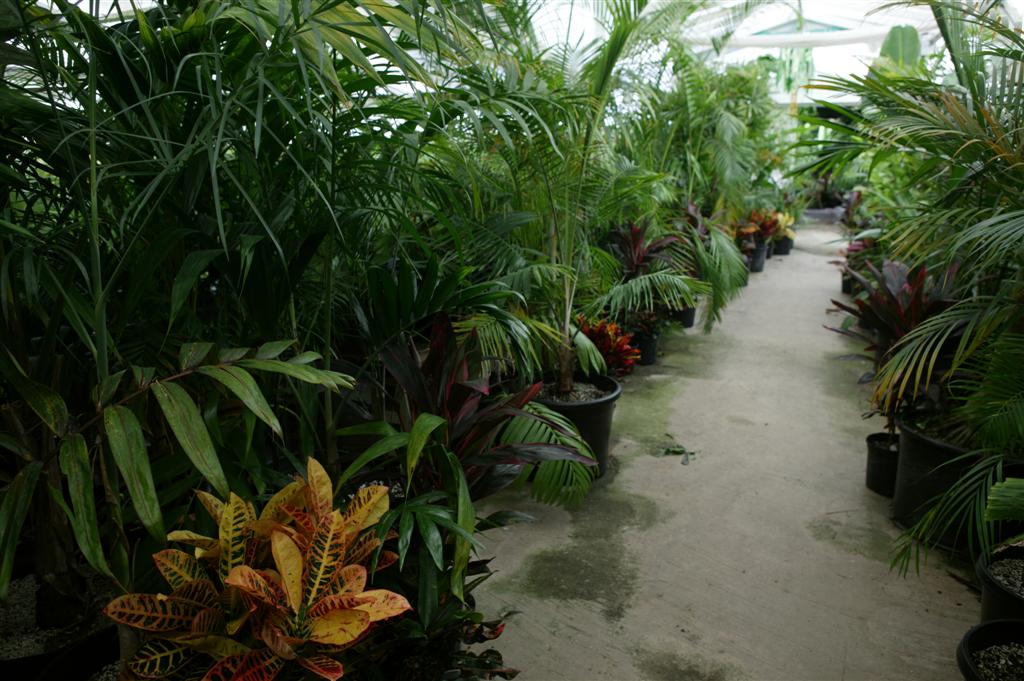
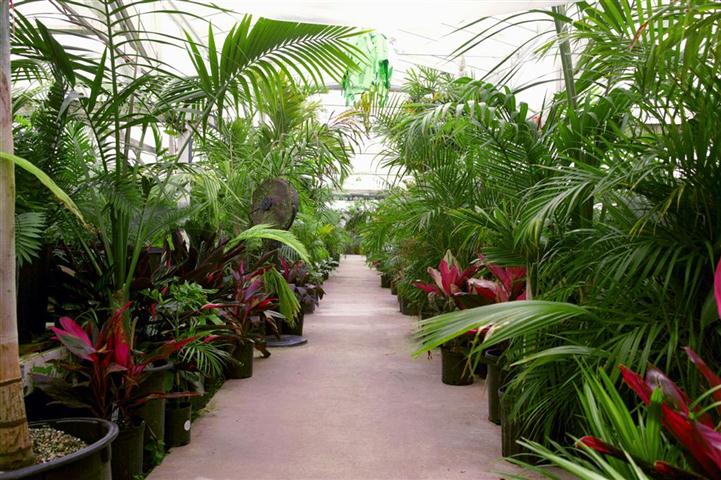
- PALM TREES, CYCADS & TROPICAL PLANT BLOG - October 1, 2020
- TRACHYCARPUS
The Windmill Palm - September 30, 2020 - FAN PALMS –
PALMS WITH CIRCULAR LEAVES - September 29, 2020












